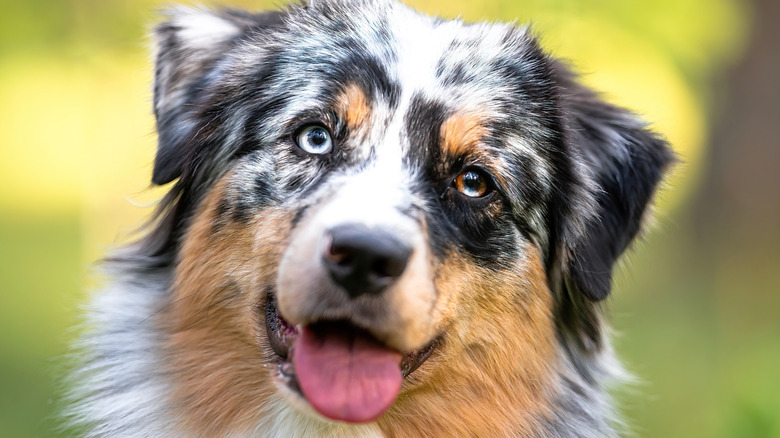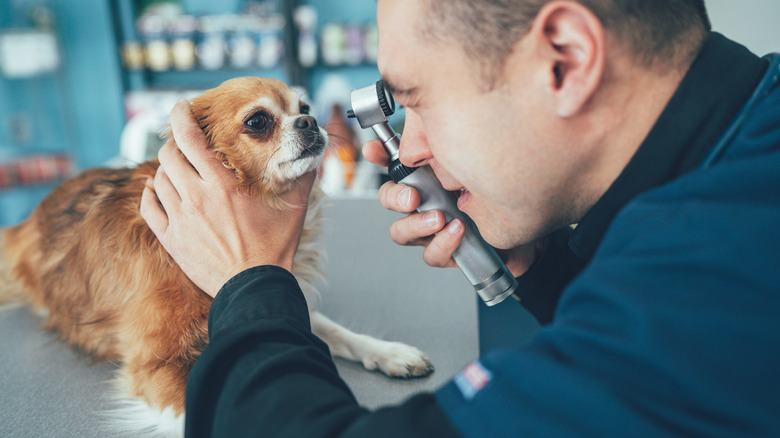Well Actually, Dogs Aren't Totally Colorblind
It's a common misconception that dogs are totally colorblind. Perpetuated by TV, movies, and outdated conclusions from early research, this myth leads people to believe that canines are among the animals that can only see in black and white. But contrary to popular belief, canines can perceive color — just not as well as we can.
Like most myths, the idea of the colorblind canine has origins in the truth. Dogs are indeed red-green colorblind, which means they can't distinguish between the two colors. From a dog's perspective, a red apple and a green apple may appear to be the same yellowish-brown color. However, dogs have dichromatic color vision, which means they can discern between blues, yellows, and various hues of the two. Complete color blindness is called monochromatic vision, which is more akin to the black-and-white vision that so many people incorrectly assume dogs possess.
The ability to see and distinguish between different colors all boils down to the number of cone subtypes an animal's eye has. Cones are photoreceptor cells within the retina that can detect the wavelength of visual light and interpret it as a specific color. Humans have three types of cones, which correspond to long, medium, and short wavelengths of light. Dogs lack that first type, the long wavelength receptor, making "warmer" colors harder to distinguish.
What the world of colors looks like to a dog
Unfortunately, imagining what dogs see isn't as simple as adding or erasing colors from the color wheel and replacing them with shades of grey. Dogs may lack a third subtype of cone in their eyes, but there's quite a bit of overlap in the spectrum of light that two different subtypes of cones can detect. And to make things even harder, scientists can't simply ask dogs to describe how they see the world.
Instead, researchers must compare dog color vision to our own to surmise how dogs see the world. For one, because dogs lack the long-wavelength "red" cone, their color perception is likely comparable to that of human beings with red-green color blindness. Such people often describe green colors as washed-out tones of blue or yellow, but never both at once (since combining blue and yellow produces green). Different shades of orange and red are also indistinguishable to people with red-green color blindness, instead appearing as a single brownish-gray color.
Canine behavior also gives us clues. Dogs prefer yellow and blue toys over red, orange, and green ones. Ironically, dog owners buy red and orange toys more frequently. The reason dogs prefer yellow and blue toys is likely because those are the colors that appear more vibrant and pop out from the surroundings, grabbing a dog's attention. This may explain why dogs like tennis balls so much; the bright yellow color is starkly distinguishable from the green grass, allowing dogs to easily keep track during a game of fetch.
Other ways dogs see differently than we do
Color isn't the only way that canine vision differs from our own. Dogs have much weaker visual acuteness compared to us humans, so their world is presumably quite blurry. In a study summarized in Psychology Today, researchers analyzed canines' visual acuity by comparing responses to increasingly closer rows of printed lines, similar to the way we test human vision using eye charts. The results suggest that dogs have 20/75 vision (normal human vision is 20/20). Thus, dogs likely have a very blurry view of the world, as if looking through "a light coat of petroleum jelly."
Yet, while dogs have deficiencies in their color perception and visual acuteness, they have strengths in other areas. For one, dogs have more rods in their eyes than we do. Like cones, rods are photoreceptor cells in the retina that detect light. Unlike cones, rods convey information about light intensity, which helps discern movement. As a result, dogs can detect movement better than we can. This may be an adaptation from their ancestors' hunting days, but now it explains why dogs can so easily track a zig-zagging fly as it buzzes around the room.
Dogs also have better night vision than us. The abundance of rods helps increase their sensitivity to light, but canine eyes have another tool for seeing in the dark: the tapetum. Many animals possess a tapetum lucidum membrane, which is a layer of reflective cells found behind the retina. When light passes through the retina, these cells bounce the light back again, essentially duplicating light information for the retina. If your dog ever lunged after a critter that you couldn't see during a night walk, you can blame their tapetum for helping them see in the dark.


